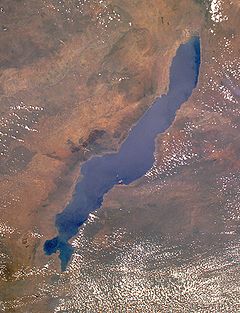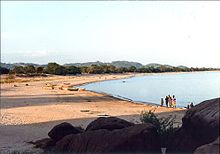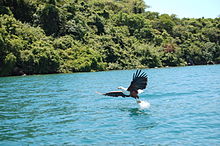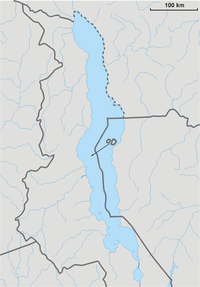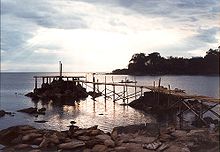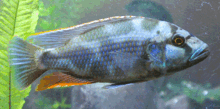
Lake Malawi
About this schools Wikipedia selection
SOS Children, an education charity, organised this selection. SOS Children works in 45 African countries; can you help a child in Africa?
Lake Malawi (Lake Nyasa, or Lago Niassa in Mozambique), is an African Great Lake and the southernmost lake in the East African Rift system, located between Malawi, Mozambique and Tanzania. The third largest and second deepest lake in Africa, it is also the ninth largest in the world. It is reportedly the habitat of more species of fish than any other body of freshwater, including more than 1000 species of cichlids, and was officially declared a reserve by the Government of Mozambique on June 10, 2011.
Geography
Lake Malawi is between 560 kilometres (350 mi) and 580 kilometres (360 mi) long, and about 75 kilometres (47 mi) wide at its widest point. The total surface area of the lake is about 29,600 square kilometres (11,400 sq mi). The lake has shorelines on western Mozambique, eastern Malawi, and southern Tanzania. The largest river flowing into it is the Ruhuhu River, and there is an outlet at its southern end, the Shire River, a tributary that flows into the very large Zambezi River in Mozambique.
The lake lies in a valley formed by the opening of the East African Rift, where the African tectonic plate is being split into two pieces. This is called a divergent plate tectonics boundary. It is variously estimated at about 40,000 years old or about one to two million years. The lake is about 350 kilometres (220 mi) southeast of Lake Tanganyika, another of the great lakes of the East African Rift.
European discovery and colonization
The Portuguese trader Candido José da Costa Cardoso was the first European to visit the lake in 1846. David Livingstone reached the lake in 1859, and naming it "Lake Nyasa". Much of the African region surrounding this lake was soon claimed by the British Empire and formed into the colony of Nyasaland. Although the Portuguese took control of the eastern shore of this lake, the island of Likoma was used as a mission station by the Universities' Mission to Central Africa, and as a result, Likoma and the nearby islet of Chizumulu were incorporated into Nyasaland rather than to Mozambique. Today, these islets form lacustrine exclaves: Malawian land surrounded by Mozambiquian waters.
On August 16, 1914, Lake Malawi was the scene of a brief naval battle when the British gunboat SS Gwendolen, commanded by a Captain Rhoades, heard that World War I had broken out, and he received orders from the British Empire's high command to "sink, burn, or destroy" the German Empire's only gunboat on the lake, the Hermann von Wissmann, commanded by a Captain Berndt. Rhoades's crew found the Hermann von Wissmann in a bay near " Sphinxhaven", in German East African territorial waters. Gwendolen disabled the German boat with a single cannon shot from a range of about 1,800 metres (2,000 yd). This very brief gunboat conflict was hailed by The Times in England as the British Empire's first naval victory of World War I. Up until that time, the lakeshore that is now in Tanzania had been a part of German East Africa.
Borders
The largest portion of the area of the lake is in Malawi. However, about a quarter of the area belongs to Mozambique. This area includes the waters surrounding the Malawian islets of Likoma and Chizumulu, which are this lake's only two inhabited islets. The islet of Likoma is dominated by a large stone and brick Anglican cathedral that was built by missionaries in the early 20th century. A notable feature of both islets is their significant number of baobab trees. The islets support a population of several thousand people, who in addition to being fishermen, grow plants such as cassavas, bananas, and mangoes for food.
Name dispute
The geographic name of the lake is disputed. Malawi claims that it is named "Lake Malawi", whereas other countries bordering on the lake, such as Mozambique and Tanzania, claim that the name is "Lake Nyasa". The origin of the dispute over the name has its background in geopolitical disputes that began before the independence of Malawi was achieved in 1964, when the territory had been known as "Nyasaland".
Further complications emerged for political reasons during the 1960s, when President Hastings Banda of Malawi became the only African leader to establish diplomatic relations with the white-ruled country of South Africa. This recognition of the South African regime was fiercely repudiated by almost all other African leaders, including President Julius Nyerere of Tanzania. This contrasting in policies toward South Africa gave some more impetus to disputes between Malawi and Tanzania, especially concerning the name of the lake itself — the water boundary between the two countries.
For this same lake, the name "Lac Maravi" had been used on the map of "Afrique sud" by J.B.B. d'Anville, which was published in France in 1749. David Livingstone's name for the lake was based on his colleague's misunderstanding of African languages of the area. When Livingstone asked his staff members, who were not from the area of the lake, to state its name for him, they said the word "nyasa", not realizing that this was the local word for any large body of water (such as a lake). In effect, "Lake Nyasa" literally means "Lake Lake". This name could also be spelled "niassa", "nyanja", or "nyanza", based on the other languages of the region.
Presently, the dispute between the two governments over the lake's name is mostly dormant. Diplomatic relations between Malawi and Tanzania, and the relationships between their wildlife police forces and other associations, are largely cordial.
Tanzania–Malawi dispute
The partition of the lake's surface area between Malawi and Tanzania is under dispute. Tanzania claims that the international border runs through the middle of the lake. On the other hand, Malawi claims the whole of the surface of this lake that is not in Mozambique, including the waters that are next to the shoreline of Tanzania. Both sides cite the Heligoland Treaty of 1890 between Great Britain and Germany concerning the border. A wrinkle in this dispute occurred when the British colonial government, just after they had captured Tanganyika from Germany, placed all of the waters of the lake under a single jurisdiction, that of the territory of Nyasaland, without a separate administration for the Tanganyikan portion of the surface. Later in colonial times two jurisdictions were established. In 1954 an agreement was signed between the British and the Portuguese making the middle of the lake their boundary with the exception of Chisamulo Island and Lokoma Island which were kept by the British and are now part of Malawi.
The dispute came to a head in 1967 when Tanzania officially protested to Malawi, however nothing was settled. Occasional flare-ups of conflict occurred during the 1990s, and also sometimes in the 21st century, have impacted fishing rights, particularly those of Tanzanian fishermen who reside on the lakeshore, and who have occasionally been accused of fishing in Malawian waters. In 2012, Malawi's oil exploration initiative brought the issue to the fore, with Tanzania demanding that exploration cease until the dispute was settled.
Lake of Stars
"The Lake of Stars" is the nickname for Lake Malawi coined by David Livingstone. This name came about due to lights from the lanterns of the fishermen in Malawi on their boats, that resemble, from a distance, stars in the sky.
The lake is also known as the Lake of Storms, for the unpredictable and extremely violent gales that sweep through the area.
Transport
Large-scale transport between villages on the shores of Lake Malawi, and also between the lakeshore and the inhabited islets, is provided by steamboats or motor ships on the lake, or else by air transport.
MV Chauncy Maples began service on the lake in 1901 as the SS Chauncy Maples: a floating clinic and church for the Universities' Mission to Central Africa. She later served as a ferry and is currently being renovated into a mobile clinic at Monkey Bay. The renovation is expected to be complete during the first half of 2014.
MV Mpasa entered service in 1935.
The ferry MV Ilala entered service in 1951. In recent years she has often been out of service, but when operational she runs between Monkey Bay at the southern end of the lake to Karonga on the northern end, and occasionally to the Iringa Region of Tanzania.
The ferry MV Mtendere entered service in 1980. By 1982 she was carrying 100,000 passengers per year. She normally serves the southern part of the lake but if Ilala is out of service she operates the route to Karonga.
The Tanzanian ferry MV Songea was built in 1988. Her operator was the Tanzania Railway Corporation Marine Division until 1997, when it became the Marine Services Company Limited. Songea plies weekly between Liuli and Nkhata Bay via Itungi and Mbamba Bay.
Vessels travel about twice a week from Nkhata Bay on the lakeshore to the Likoma and Chizumulu islets, taking several hours to make the crossing. Neither of the islets has a usable port, and larger boats anchor offshore before transferring their passengers and cargoes to the islets in small watercraft.
Wildlife
Lake Malawi or Nyasa has for millennia provided a major food source to the residents of its shores since its waters are rich in fish such as the chambo, consisting of any one of four species of the cichlid genus Nyasalapia, and the kampango, a large catfish (Bagrus meridionalis). Some of the fish that are caught are exported from Malawi, but the wild population of fish is increasingly threatened by overfishing and water pollution.
The painted hunting dog was believed to be extinct in Malawi, however recent research in Kasungu National park near the western boundary of Malawi has found a pack of 17 Painted dogs. Researcher Duncan Yearly has begun a project called Carnivore Conservation Malawi and is trying to raise awareness and funding to further the protection of these endangered mammals in Malawi. It is believed that these painted dogs seasonally move across the border from Malawi into Zambia to hunt in The South Luangwa Valley but seemingly they have plenty of success within Malawi as the pack consists of 7 adults and 10 pups. Other wildlife that is found in and around Lake Malawi or Nyasa include crocodiles, hippopotamus, monkeys, and a significant population of African fish eagles that feed off fish from the lake.
Cichlids
Lake Malawi is noted for being the site of evolutionary radiations among several groups of animals, most notably cichlid fish. Several hundred endemic species are found in the lake, many of which have become popular among aquarium owners due to their bright colors. Recreating a Lake Malawi/Nyasa biotope to host cichlids became quite popular in the aquarium hobby. The cichlids of the lake are divided into two basic groups, loosely referred to as the haplochromines and the tilapiines. Within the first group, Haplochrominae, there are two subgroups. The first one consists of open water and sand dwelling species whose males display bright colors and whose females show a silvery coloration with sometimes irregular black bars or other markings. The second subgroup is known both locally and popularly as mbuna, which means "rockdwellers". The Mbuna species tend to be smaller, often specialized aufwuchs feeders, and often both sexes are brightly colored with males having several egg shaped gold spots on their anal fin. All haplochromines from Lake Malawi/Nyasa are mouthbrooders.
The second group, the tilapiines, comprises the only substrate-spawning species in the lake ( Tilapia rendalli), in addition to the four mouthbrooding species of chambo (Nyasalapia).
Snails
The lake also supports populations of snails, some of which carry bilharzia. A survey in Monkey Bay in 1964 found two endemic species of snails of the genus Bulinus in the lake, and B. globosus and B. forskalli in lagoons separated from it. The latter species are known vectors of bilharzia, and larvae of the parasite were detected in water containing these, but in experiments C. Wright of the British Museum of Natural History was unable to infect the two species endemic to the lake with the parasites. The field workers, who spent many hours on and in the lake, did not find either B. globosus or B. forskalli in the lake itself.
A number of fish species in the lake specialise in preying on snails, and the lake snails show behavioural modifications that give them some protection. One lives at the bases of rosettes of the plant Vallisneria, while the other burrows in the sand. The bilharzia vector, B. globosus, crawls over the leaves of aquatic plants and so is more susceptible to predation. In the early 1960s the snail-eating fish were still abundant, and bilharzia was not a problem to people bathing in the lake but they could contract it if they paddled in streams, ponds or swamps near the lake. Infective larvae may have been carried into the lake during floods, although they would have survived only a few days. More recently there have been reports of this disease being contracted in the lake. The apparent increase in risk may be associated with heavy fishing off the beaches over the past 40 years and with declines in the populations of snail-eating fish.
In addition to the potential vectors of bilharzia, a number of other snail and clam species are endemic to the lake. Empty shells of large Lanistes are used as brood shelters by mbuna such as Pseudotropheus livingstonei, while a small catfish, which grows to less than 30 mm in length, uses smaller shells as brood shelters.
Water chemistry
The water in Lake Malawi or Nyasa is typically slightly alkaline with a pH ranging from 7.7 to 8.6, a carbonate hardness of 107 to 142 mg L−1, and a conductivity of 210 to 285 µS cm−1. Given its tropical latitude, the water of this lake is generally warm, having a surface temperature that ranges from 24 to 29 degrees Celsius (75 to 84 degrees Fahrenheit), with a deep water temperature of about 22 °C (72 °F), year round.
Recreation on the lake
Lake Malawi is one of the main attractions in Malawi for local and international tourists because of its beaches and islands. Many Malawians go to the lake for Christmas vacations and other holidays for recreational purposes. International tourists visiting Malawi also go to the lake for recreation. Some of Malawi's best resorts are on Lake Malawi. Resorts offer a wide range of activities like snorkeling, diving, boat riding, sailing, water skiing, camping, trips to the islands located along the lake, beach football and other water activities.
Literature
The Lake has been romanticised in Malawian literature and is at the centre of many Malawian poems and novels.
Religion
Traditional Malawian religion centers on the lake as an integral part of the source of life.
